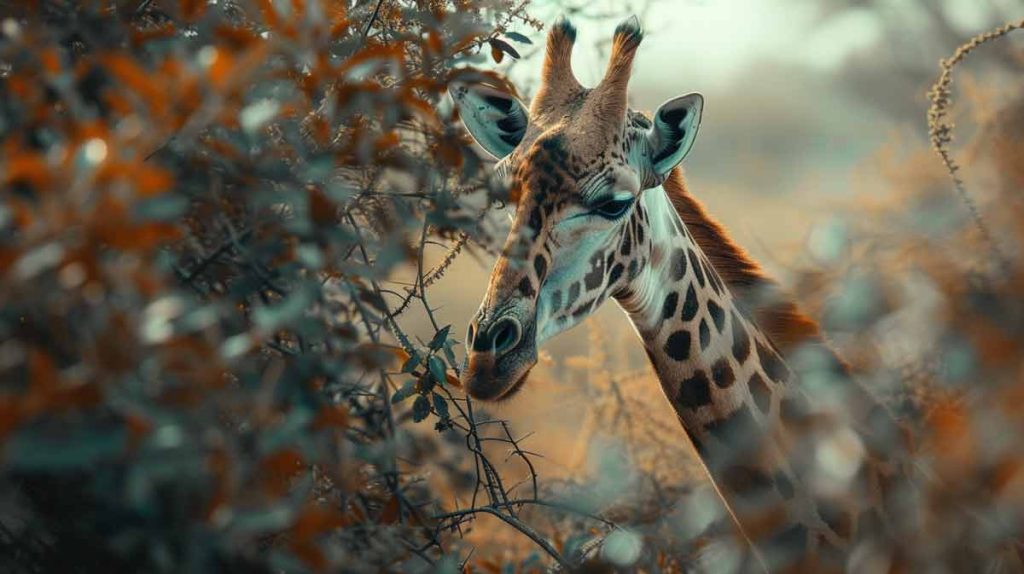Did you know that giraffes are born with a peculiar set of “horns” unlike any other animal? These so-called horns, known as ossicones, are a fascinating feature of giraffes and play a unique role in their lives. Let’s delve into the surprising truth about giraffe horns and discover the evolution behind these remarkable appendages.
Key Takeaways:
- Giraffes have a distinctive set of horns called ossicones.
- Ossicones are bony projections covered with furred skin.
- Male giraffes usually have more extensive and thicker ossicones.
- Ossicones are not actual horns and are made of ossified cartilage.
- These unique features contribute to male giraffes’ combat behaviour known as “necking.”
The Unique Physical Features of Giraffes
In addition to their ossicones, giraffes possess various unique physical features that make them fascinating creatures. These include:
- Long Legs: Giraffes have long legs that allow them to reach leaves high in the trees, which other animals cannot access.
- Large Eyes and Long Eyelashes: Giraffes have big eyes that provide excellent vision and long eyelashes that protect them against debris and insects.
- Striking Coat Patterns: The giraffe’s coat is adorned with beautiful and distinctive patterns that offer camouflage in their natural habitat, helping them blend in with the surrounding vegetation.
- Calm Demeanor: Giraffes are known for their gentle and tranquil nature, even in potentially dangerous situations.
Giraffes are the tallest mammals on Earth, with necks measuring up to 25 cm each despite having the same number of vertebrae as humans and other mammals. Their long necks play a crucial role in their ritualized fights called “necking,” where males swing their necks to deliver powerful head-butts to their opponents’ bodies. This behaviour showcases the unique strength and adaptability of the giraffe’s neck.

Giraffes have a relatively minor heart for their size, yet they must maintain high blood pressure to ensure blood flow to their brains. Their hearts beat up to 170 times per minute, and the rete mirabile, a pressure-regulation system in their necks, helps prevent excess blood flow to the brain when the giraffe lowers its head to drink.
The distinctive coat patterns of giraffes, often called their “fingerprint,” are unique to each individual and serve multiple functions. Not only do they provide camouflage in their environment, but these patterns also assist with thermoregulation by helping to dissipate heat and regulate body temperature.
Rete Mirabile
“The rete mirabile, a pressure-regulation system in their necks, helps prevent excess blood flow to the brain when the giraffe lowers its head to drink.”
These physical features collectively contribute to giraffes’ extraordinary adaptability and survival in their habitats. Their long legs, keen eyesight, unique coat patterns, and calm demeanour make them remarkable creatures in the animal kingdom.
The Conservation Status of Giraffes
Giraffes, beloved and iconic animals, face significant conservation challenges. In recent years, the giraffe population has declined by 40%, leaving fewer than 90,000 giraffes in Africa. The situation is dire, with giraffes already extinct in at least seven countries.
Habitat loss, fragmentation, and degradation pose significant threats to giraffe populations. The expansion of human settlements and agriculture reduces the space for these magnificent creatures to roam freely. Moreover, poaching and human encroachment further contribute to the alarming decline in giraffe numbers.

Conservation efforts are vital to protecting giraffes and their habitats. Organizations like the Giraffe Conservation Foundation actively work to raise awareness, conduct research, and implement conservation initiatives. Their goal is to ensure the survival of giraffes in the wild and prevent their extinction.
It is essential to recognize the value of giraffes and the urgent need for conservation actions. By supporting giraffe conservation efforts, we can help preserve these majestic animals for future generations and protect our planet’s biodiversity.
FAQ:
What are ossicones?
Ossicones are the cartilage or bone protrusions on the top of a giraffe’s head. They are called horns and are covered in hair.
Do giraffes have horns?
Giraffes have horn-like structures called ossicones on top of their heads.
Do male and female giraffes have horns?
Both male and female giraffes have ossicones, although they may look different in shape and size.
What is the purpose of giraffe horns?
Giraffes use their horns for fighting, establishing dominance, and foraging in trees.
How do male giraffes use their horns?
Male giraffes use their horns to combat and establish dominance within their herd.
What are some exciting giraffe facts related to horns?
Male giraffes have more extensive and more prominent ossicones than females. Additionally, giraffes use their horns not only for fighting but also for reaching high branches for food.
Are giraffes the only mammals with horns?
No, other mammals, such as antelopes and some species of deer, also have horns or antlers.
How many ossicones do giraffes have?
Most giraffe species have two ossicones, but the reticulated giraffe can have up to five.
Are giraffes born with horns?
Yes, a baby giraffe is born with ossicones, although they are not fully ossified at birth.
What is the tallest giraffe species concerning horns?
The reticulated giraffe is known to have the tallest and most distinct ossicones among the different giraffe species.
